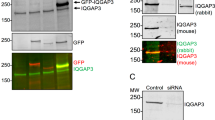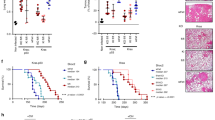Abstract
In contrast to its growth-inhibitory effect on primary mesenchymal cells, RAS oncogene activation induces a proliferative phenotype in normal human thyroid epithelial cells in vitro, consistent with its putative role in tumour initiation. Using this model, we previously showed that activation of the MAP kinase (MAPK) pathway is necessary, but not sufficient for the proliferative response to mutant (V12) H-RAS. Here we extend this work to show that another major RAS effector – phosphatidylinositol-3-kinase (PI-3-K) – while also insufficient alone, is able to synergize with MAPK activation to mimic the effect of mutant RAS, albeit at reduced efficiency. Furthermore we show that PI-3-K is an absolute requirement for the proliferative response to RAS in these cells, acting via suppression of RAS-induced apoptosis. These data extend our understanding of RAS signalling in a clinically-relevant cell context and point to the use of PI-3-K inhibitors as potential therapeutic agents for targetting human cancers induced by RAS mutation.
This is a preview of subscription content, access via your institution
Access options
Subscribe to this journal
Receive 50 print issues and online access
$259.00 per year
only $5.18 per issue
Buy this article
- Purchase on Springer Link
- Instant access to full article PDF
Prices may be subject to local taxes which are calculated during checkout




Similar content being viewed by others
References
Alessi DR, Cuenda A, Cohen P, Dudley DT and Saltiel AR . 1995 J Biol Chem 270: 27489–27494
Almoguera C, Shibata D, Forrester K, Martin J, Arnheim N and Perucho M . 1988 Cell 53: 549–554
Bond JA, Wyllie FS, Rowson J, Radulescu A and Wynford-Thomas D . 1994 Oncogene 9: 281–290
Bos JL . 1989 Cancer Res 49: 4682–4689
Brunet A, Bonni A, Zigmond MJ, Lin MZ, Juo P, Hu LS, Anderson MJ, Arden KC, Blenis J and Greenberg ME . 1999 Cell 96: 857–868
Cardone MH, Roy N, Stennicke HR, Salvesen GS, Franke TF, Stanbridge E, Frisch S and Reed JC . 1998 Science 282: 1318–1321
Cass L, Summers S, Prendergast G, Backer J, Birnbaum M and Meinkoth J . 1999 Mol Cell Biol 19: 5882–5891
Chung J, Kuo CJ, Crabtree GR and Blenis J . 1992 Cell 69: 1227–1236
Cobellis G, Missero C and Di Lauro R . 1998 Oncogene 17: 2047–2057
Cowley S, Paterson H, Kemp P and Marshall CJ . 1994 Cell 77: 841–852
Cox AD and Der CJ . 1997 BBA 1333: F51–F71
Datta SR, Dudek H, Tao X, Masters S, Fu H, Gotoh Y and Greenberg ME . 1997 Cell 91: 231–241
Francis-Lang H, Zannini M, De Felice M, Berlingieri MT, Fusco A and Di Lauro R . 1992 Mol Cell Biol 12: 5793–5800
Franke TF, Yang SI, Chan TO, Datta K, Kazlauskas A, Morrison DK, Kaplan DR and Tsichlis PN . 1995 Cell 81: 727–736
Gallagher AP, Burnett AK, Dowen DT and Darley RL . 1998 Cancer Res 58: 2029–2035
Gire V and Wynford-Thomas D . 1998 Mol Cell Biol 18: 1611–1621
Gire V, Marshall C and Wynford-Thomas D . 1999 Oncogene 18: 4819–4832
Hall-Jackson C, Jones T, Eccles N, Dawson T, Bond J, Gescher A and Wynford-Thomas D . 1998 Br J Cancer 78: 641–651
Ivan M, Bond JA, Prat M, Comoglio PM and Wynford-Thomas D . 1997 Oncogene 14: 2417–2423
Joneson T, White MA, Wigler MH and Bar-Sagi D . 1996 Science 271: 810–812
Kauffmann-Zeh A, Rodriguez-Viciana P, Ulrich E, Gilbert C, Coffer P, Downward J and Evan G . 1997 Nature 385: 544–548
Khosravi-Far R, White MA, Westwick JK, Solski PA, Chrzanowska-Wodnicka M, Van Aelst L, Wigler MH and Der CJ . 1996 Mol Cell Biol 16: 3923–3933
Leevers SJ and Marshall CJ . 1992 EMBO J 11: 569–574
Lemoine NR, Mayall ES, Jones T, Sheer D, McDermid S, Kendall-Taylor P and Wynford-Thomas D . 1989a Br J Cancer 60: 897–903
Lemoine NR, Mayall ES, Wyllie FS, Williams ED, Goyns M, Stringer B and Wynford-Thomas D . 1989b Oncogene 4: 159–164
Lemoine NR, Staddon S, Bond J, Wyllie FS, Shaw JJ and Wynford-Thomas D . 1990 Oncogene 5: 1833–1837
Marshall CJ . 1996 Curr Biol 8: 197–204
McCarthy SA, Samuels ML, Pritchard CA, Abraham JA and McMahon M . 1995 Genes Dev 9: 1953–1964
Miller MJ, Rioux L, Prendergast GV, Cannon S, White MA and Meinkoth JL . 1998 Mol Cell Biol 18: 3718–3726
Oldham SM, Clark GJ, Gangarosa LM, Coffey RJ and Der CJ . 1996 Proc Natl Acad Sci USA 93: 6924–6928
Rodriguez-Viciana P, Warne PH, Vanhaesebroeck B, Waterfield MD and Downward J . 1996 EMBO J 15: 2442–2451
Rodriguez-Viciana P, Warne PH, Khwaja A, Marte BM, Pappin D, Das P, Waterfield MD, Ridley A and Downward J . 1997 Cell 89: 457–467
Serrano M, Lin AW, McCurrach ME, Beach D and Lowe SW . 1997 Cell 88: 593–602
Suarez HG, du Villard JA, Severino M, Caillou B, Schlumberger M, Tubiana M, Parmentier C and Monier R . 1990 Oncogene 5: 565–570
Treinies I, Paterson HF, Hooper S, Wilson R and Marshall CJ . 1999 Mol Cell Biol 19: 321–329
Vlahos CJ, Matter WF, Hui KY and Brown RF . 1994 J Biol Chem 269: 5241–5248
White MA, Nicolette C, Minden A, Polverino A, Van Aelst L, Karin M and Wigler MH . 1995 Cell 80: 533–541
Williams DW, Williams ED and Wynford-Thomas D . 1988 Brit J Cancer 57: 535–539
Wolthuis RM and Bos JL . 1999 Curr Opin Genet Dev 9: 112–117
Yang J-J, Kang J-S and Krauss RS . 1998 Mol Cell Biol 18: 2586–2595
Acknowledgements
We thank the Cancer Research Campaign for grant support, Dr Julian Downward for supply of retroviral vectors, and Michele Haughton for thyroid cell preparation. The editorial assistance of Theresa King is gratefully acknowledged.
Author information
Authors and Affiliations
Rights and permissions
About this article
Cite this article
Gire, V., Marshall, C. & Wynford-Thomas, D. PI-3-kinase is an essential anti-apoptotic effector in the proliferative response of primary human epithelial cells to mutant RAS. Oncogene 19, 2269–2276 (2000). https://doi.org/10.1038/sj.onc.1203544
Received:
Revised:
Accepted:
Published:
Issue Date:
DOI: https://doi.org/10.1038/sj.onc.1203544
Keywords
This article is cited by
-
Mutational and Immunohistochemical Study of the PI3K/Akt Pathway in Papillary Thyroid Carcinoma in Greece
Endocrine Pathology (2010)
-
Increased STAT-3 and synchronous activation of Raf-1-MEK-1-MAPK, and phosphatidylinositol 3-Kinase-Akt-mTOR pathways in atypical and anaplastic meningiomas
Journal of Neuro-Oncology (2009)
-
Contributions of the Raf/MEK/ERK, PI3K/PTEN/Akt/mTOR and Jak/STAT pathways to leukemia
Leukemia (2008)
-
Chromosomal imbalances associated with anaplastic transformation of follicular thyroid carcinomas
British Journal of Cancer (2004)



